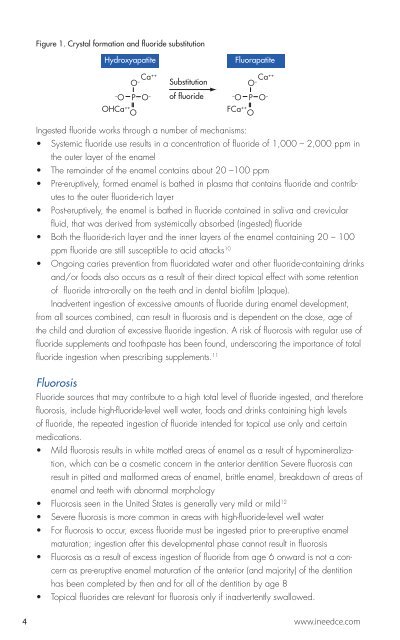Create successful ePaper yourself
Turn your PDF publications into a flip-book with our unique Google optimized e-Paper software.
Figure 1. Crystal formation and fluoride substitution<br />
Hydroxyapatite<br />
Ca ++<br />
O –<br />
– O P O –<br />
OHCa ++ O<br />
Substitution<br />
of fluoride<br />
Fluorapatite<br />
Ca ++<br />
O –<br />
– O P O –<br />
FCa ++ O<br />
Ingested fluoride works through a number of mechanisms:<br />
• Systemic fluoride use results in a concentration of fluoride of 1,000 – 2,000 ppm in<br />
the outer layer of the enamel<br />
• The remainder of the enamel contains about 20 –100 ppm<br />
• Pre-eruptively, formed enamel is bathed in plasma that contains fluoride and contributes<br />
to the outer fluoride-rich layer<br />
• Post-eruptively, the enamel is bathed in fluoride contained in saliva and crevicular<br />
fluid, that was derived from systemically absorbed (ingested) fluoride<br />
• Both the fluoride-rich layer and the inner layers of the enamel containing 20 – 100<br />
ppm fluoride are still susceptible to acid attacks 10<br />
• Ongoing caries prevention from fluoridated water and other fluoride-containing drinks<br />
and/or foods also occurs as a result of their direct topical effect with some retention<br />
of fluoride intra-orally on the teeth and in dental biofilm (plaque).<br />
Inadvertent ingestion of excessive amounts of fluoride during enamel development,<br />
from all sources <strong>com</strong>bined, can result in fluorosis and is dependent on the dose, age of<br />
the child and duration of excessive fluoride ingestion. A risk of fluorosis with regular use of<br />
fluoride supplements and toothpaste has been found, underscoring the importance of total<br />
fluoride ingestion when prescribing supplements. 11<br />
Fluorosis<br />
<strong>Fluoride</strong> sources that may contribute to a high total level of fluoride ingested, and therefore<br />
fluorosis, include high-fluoride-level well water, foods and drinks containing high levels<br />
of fluoride, the repeated ingestion of fluoride intended for topical use only and certain<br />
medications.<br />
• Mild fluorosis results in white mottled areas of enamel as a result of hypomineralization,<br />
which can be a cosmetic concern in the anterior dentition Severe fluorosis can<br />
result in pitted and malformed areas of enamel, brittle enamel, breakdown of areas of<br />
enamel and teeth with abnormal morphology<br />
• Fluorosis seen in the United States is generally very mild or mild 12<br />
• Severe fluorosis is more <strong>com</strong>mon in areas with high-fluoride-level well water<br />
• For fluorosis to occur, excess fluoride must be ingested prior to pre-eruptive enamel<br />
maturation; ingestion after this developmental phase cannot result in fluorosis<br />
• Fluorosis as a result of excess ingestion of fluoride from age 6 onward is not a concern<br />
as pre-eruptive enamel maturation of the anterior (and majority) of the dentition<br />
has been <strong>com</strong>pleted by then and for all of the dentition by age 8<br />
• Topical fluorides are relevant for fluorosis only if inadvertently swallowed.<br />
4 www.ineedce.<strong>com</strong>

















